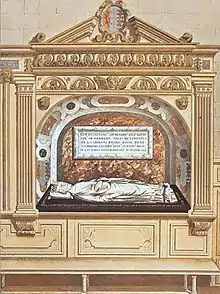Leo V of Armenia
Leo V or Levon V (occasionally Levon VI; Armenian: Լեւոն, Levon V; 1342 – 29 November 1393), of the House of Lusignan, was the last Latin king of the Armenian Kingdom of Cilicia. He ruled from 1374 to 1375.
| Levon V | |
|---|---|
 | |
| King of Armenia | |
| Reign | 1374–1375 |
| Coronation | 14 September 1374 |
| Predecessor | Constantine IV |
| Born | c. 1342 Cyprus |
| Died | 29 November 1393 (aged 50–51) Hôtel des Tournelles, Paris |
| Burial | |
| Spouse | Margaret of Soissons |
| House | Poitiers-Lusignan |
| Father | John of Poitiers-Lusignan |
| Mother | Soldane Bagrationi of Georgia |
| Religion | Armenian Catholic |
| Signature | |
Leo was described as "Leo V, King of Armenia" on his own personal seal (Sigilum Leonis Quinti Regis Armenie),[1] and as "Leo of Lusignan the Fifth" in the Middle French inscription on his cenotaph: Leon de Lizingnen quint.[2]
Life in Europe
Leon de Lusignan arrived ill and poor to Medina del Campo. In 1382 or 1383, the King of Castile named Leon Lord of Madrid.[3] John I granted him for life the town of Madrid, Andújar, Guadalajara and Villareal (today Ciudad Real) and a yearly gift of 150,000 maravedis.[4] Leon rebuilt the towers of the Royal Alcázar.
According to father Juan de Mariana, Leon left Castile for France after the death of his protector in 1390. Federico Bravo, however, states that he left after two years of ruling, and five years later, the Madrilenians were conceded the revocation of the lordship by John. Leon V apparently went to Paris in June 1384, and received the Saint-Ouen castle and a sizable pension from King Charles VI of France.[5] He attempted to reconcile the French and the English (at the time fighting the Hundred Years' War) in order to set up a new Crusade[1] and obtain help to recover his lands, but the meeting he organized in 1386 between Boulogne and Calais were unsuccessful.[5] Leon continued his diplomatic mission to England in 1389 and in 1392.
Death

Leon V never recovered his throne, and died in Paris on November 29, 1393. His remains were laid to rest in the Couvent des Célestins, the second most important burial site for royalty after Saint-Denis, located near what is now the Place de la Bastille in Paris.[6] The prestigious convent was located nearby Leon's residence of Hôtel des Tournelles, itself near Hôtel Saint-Pol, the favourite residence of Charles V and Charles VI in the area of Le Marais.
Leon received lavish funerals and had a lavish tomb, located in the choir of the church. However, the convent was profanated during the French Revolution.[1][6] After the revolution, his tombstone was recovered by Alexandre Lenoir who placed it in his Musée des monuments Français in the Saint-Denis Basilica. In 1815, during the Restoration, a new cenotaph was established for Leon V at the royal Saint Denis Basilica where most representatives of the French monarchy lie.
The effigy on the tombstone, by an anonymous artist, is of a high realism and quality, and it is thought that it was made while Leon was still alive.[5] Leon V is depicted holding a scepter (now broken) and gloves, symbol of great princes. The tombstone bears the following inscription in Old French:[7]
Cy gist tres noble et excellent prince Leon de Lizingnen quint roy latin du royaume d'Armenie qui rendit l'ame a Dieu a Paris le XXIXe jour de novembre l'an de grace M.CCC.IIIIXX.XIII.
Priez pour luy.
English translation:[8]
Here lies the right noble and excellent Prince Leon de Lusignan V, Latin king of the kingdom of Armenia, who passed away in Paris on the 29th day of November of the year of Grace 1393. Pray for him.

He had one legitimate daughter, Marie de Lusignan (ca 1370 – Cairo, before July 4, 1381, who predeceased her mother and father), and two illegitimate sons, Guy de Lusignan or Guido de Armenia (died 1405), a Canon in Autun, Bayeux, Paris and Arras and Captain de la Tour d'Amblay, and Stephan or Etienne de Lusignan, a Knight in Sis.
Upon his death the title of King of Armenia was claimed by Leo's distant cousin James I.
See also
Notes
- Mutafian, p.90
- Full text of the cenotaph with translation hereunder.
- Un Madrid insólito: Guía para dejarse sorprender, pg. 39–40. Jesús Callejo. Editorial Complutense, 2001. ISBN 84-7491-630-5. The book, however, talks about Leon V of Armenia since Leo I of Armenia isn't counted as a King by some authors.
- "¿Sabías que Madrid fue durante 8 años un reino independiente?".
- Mutafian, Leon V
- Basmadjian, K. J. (Nov–Dec 1920). "Cilicia: Her Past and Future". The New Armenia. 12 (11–12): 168–9.
- "Tombeau du roi Léon V de Lusignan". acam-france.org (in French). Association Culturelle Arménienne de Marne-la-Vallée (France). Archived from the original on 23 January 2021.
- Translation by Pierre-Yves Le Pogam, Tomb of Leon V de Lusignan
References
- Boase, T. S. R. (1978). The Cilician Kingdom of Armenia. Edinburgh: Scottish Academic Press. ISBN 0-7073-0145-9.
- Mutafian, Claude (2001). Le Royaume Arménien de Cilicie. Paris: CNRS Editions. ISBN 2-271-05105-3.
- Claude Mutafian, Leon V of Lusignan, last king of Armenia (PDF)
- Pierre-Yves Le Pogam, Tomb of Leon V de Lusignan (PDF)